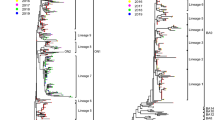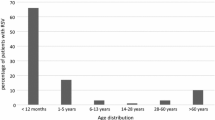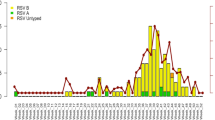Abstract
We investigated the molecular epidemiology of respiratory syncytial virus (RSV) isolated from children during 28 consecutive seasons (1990-2018) and the genetic variability of the duplication region of RSV genotypes ON1 and BA in South Korea. RSV was identified using culture-based methods in Hep-2 cells and was grouped as RSV-A or RSV-B by an immunofluorescence assay. The second hypervariable region of the G gene was sequenced for genotyping. The nucleotide and deduced amino acid sequences of the duplication region of RSV ON1 and BA were analyzed. A total of 670 RSV-A and 233 RSV-B isolates were obtained. For RSV-A, the NA1 genotype predominated during the 2004/2005-2011/2012 seasons. The ON1 genotype was first detected in 2011 and has since replaced all other genotypes. For RSV-B, the GB3 genotype predominated during the 1999/2000-2005/2006 seasons, but the BA genotype also replaced all other genotypes of RSV-B after the first season in which it was isolated (2005/2006). In ON1 and BA genotype RSV strains, novel sequence types of the duplication region of the G gene were identified in 50-95% and 33-80% of the isolates, respectively, in each season. The ON1 and BA9 genotypes are responsible for the current epidemics of RSV infection in South Korea. The sequences in the duplication region of the G gene have evolved continuously and might be sufficient for the identification of specific strains of the RSV-A ON1 and RSV-B BA genotypes.




Similar content being viewed by others
Data availability
The datasets generated and/or analyzed in the current study are available from the corresponding author on reasonable request.
References
Hall CB, Weinberg GA, Iwane MK et al (2009) The burden of respiratory syncytial virus infection in young children. N Engl J Med 360:588–598. https://doi.org/10.1056/NEJMoa0804877
Choi EH, Lee HJ, Kim SJ et al (2006) The association of newly identified respiratory viruses with lower respiratory tract infections in Korean children, 2000–2005. Clin Infect Dis 43:585–592. https://doi.org/10.1086/506350
Baek YH, Choi EH, Song MS et al (2012) Prevalence and genetic characterization of respiratory syncytial virus (RSV) in hospitalized children in Korea. Arch Virol 157:1039–1050. https://doi.org/10.1007/s00705-012-1267-1
Tregoning JS, Schwarze J (2010) Respiratory viral infections in infants: causes, clinical symptoms, virology, and immunology. Clin Microbiol Rev 23:74–98. https://doi.org/10.1128/CMR.00032-09
Collins PL, Graham BS (2008) Viral and host factors in human respiratory syncytial virus pathogenesis. J Virol 82:2040–2055. https://doi.org/10.1128/JVI.01625-07
Rima B, Collins P, Easton A et al (2017) ICTV virus taxonomy profile: Pneumoviridae. J Gen Virol 98:2912–2913. https://doi.org/10.1099/jgv.0.000959
Sullender WM (2000) Respiratory syncytial virus genetic and antigenic diversity. Clin Microbiol Rev 13:1–15
Wertz GW, Moudy RM (2004) Antigenic and genetic variation in human respiratory syncytial virus. Pediatr Infect Dis J 23:S19–S24. https://doi.org/10.1097/01.inf.0000108189.87181.7c
Johnson PR, Spriggs MK, Olmsted RA, Collins PL (1987) The G glycoprotein of human respiratory syncytial viruses of subgroups A and B: extensive sequence divergence between antigenically related proteins. Proc Natl Acad Sci USA 84:5625–5629
Cane PA, Pringle CR (1995) Evolution of subgroup A respiratory syncytial virus: evidence for progressive accumulation of amino acid changes in the attachment protein. J Virol 69:2918–2925
Anderson LJ, Peret TC, Piedra PA (2019) RSV strains and disease severity. J Infect Dis 219:514–516. https://doi.org/10.1093/infdis/jiy498
Kim YJ, Kim DW, Lee WJ et al (2014) Rapid replacement of human respiratory syncytial virus A with the ON1 genotype having 72 nucleotide duplication in G gene. Infection, genetics and evolution. Infect Genet Evol 26:103–112. https://doi.org/10.1016/j.meegid.2014.05.007
Park E, Park PH, Huh JW et al (2017) Molecular and clinical characterization of human respiratory syncytial virus in South Korea between 2009 and 2014. Epidemiol Infect 145:3226–3242. https://doi.org/10.1017/S0950268817002230
Park JY, Lee HJ (1999) Development of monoclonal antibodies to respiratory syncytial virus (RSV) and application for study of antigenic variation of RSV. Korean J Infect Dis 31:111–121
Choi EH, Lee HJ (2000) Genetic diversity and molecular epidemiology of the G protein of subgroups A and B of respiratory syncytial viruses isolated over 9 consecutive epidemics in Korea. J Infect Dis 181:1547–1556. https://doi.org/10.1086/315468
van Niekerk S, Venter M (2011) Replacement of previously circulating respiratory syncytial virus subtype B strains with the BA genotype in South Africa. J Virol 85:8789–8797. https://doi.org/10.1128/JVI.02623-10
Venter M, Madhi SA, Tiemessen CT, Schoub BD (2001) Genetic diversity and molecular epidemiology of respiratory syncytial virus over four consecutive seasons in South Africa: identification of new subgroup A and B genotypes. J Gen Virol 82:2117–2124. https://doi.org/10.1099/0022-1317-82-9-2117
Hu P, Zheng T, Chen J et al (2017) Alternate circulation and genetic variation of human respiratory syncytial virus genotypes in Chengdu, West China, 2009–2014. J Med Virol 89:32–40. https://doi.org/10.1002/jmv.24603
Gimferrer L, Vila J, Pinana M et al (2019) Virological surveillance of human respiratory syncytial virus A and B at a tertiary hospital in Catalonia (Spain) during five consecutive seasons (2013–2018). Future Microbiol 14:373–381. https://doi.org/10.2217/fmb-2018-0261
Okamoto M, Dapat CP, Sandagon AMD et al (2018) Molecular characterization of respiratory syncytial virus in children with repeated infections with subgroup B in the philippines. J Infect Dis 218:1045–1053. https://doi.org/10.1093/infdis/jiy256
Comas-Garcia A, Noyola DE, Cadena-Mota S et al (2018) Respiratory syncytial virus-A ON1 genotype emergence in Central Mexico in 2009 and evidence of multiple duplication events. J Infect Dis 217:1089–1098. https://doi.org/10.1093/infdis/jiy025
Luo HJ, Huang XB, Zhong HL et al (2020) Epidemiological characteristics and phylogenic analysis of human respiratory syncytial virus in patients with respiratory infections during 2011–2016 in southern China. Int J Infect Dis 90:5–17. https://doi.org/10.1016/j.ijid.2019.10.009
Pretorius MA, van Niekerk S, Tempia S et al (2013) Replacement and positive evolution of subtype A and B respiratory syncytial virus G-protein genotypes from 1997–2012 in South Africa. J Infect Dis 208:S227–S237. https://doi.org/10.1093/infdis/jit477
Eshaghi A, Duvvuri VR, Lai R et al (2012) Genetic variability of human respiratory syncytial virus A strains circulating in Ontario: a novel genotype with a 72 nucleotide G gene duplication. PLoS One 7:e32807. https://doi.org/10.1371/journal.pone.0032807
Duvvuri VR, Granados A, Rosenfeld P et al (2015) Genetic diversity and evolutionary insights of respiratory syncytial virus A ON1 genotype: global and local transmission dynamics. Sci Rep 5:14268. https://doi.org/10.1038/srep14268
Lee WJ, Kim YJ, Kim DW et al (2012) Complete genome sequence of human respiratory syncytial virus genotype A with a 72-nucleotide duplication in the attachment protein G gene. J Virol 86:13810–13811. https://doi.org/10.1128/JVI.02571-12
Trento A, Galiano M, Videla C et al (2003) Major changes in the G protein of human respiratory syncytial virus isolates introduced by a duplication of 60 nucleotides. J Gen Virol 84:3115–3120. https://doi.org/10.1099/vir.0.19357-0
Trento A, Viegas M, Galiano M et al (2006) Natural history of human respiratory syncytial virus inferred from phylogenetic analysis of the attachment (G) glycoprotein with a 60-nucleotide duplication. J Virol 80:975–984. https://doi.org/10.1128/JVI.80.2.975-984.2006
Hirano E, Kobayashi M, Tsukagoshi H et al (2014) Molecular evolution of human respiratory syncytial virus attachment glycoprotein (G) gene of new genotype ON1 and ancestor NA1. Infect Genet Evol 28:183–191. https://doi.org/10.1016/j.meegid.2014.09.030
Hotard AL, Laikhter E, Brooks K et al (2015) Functional analysis of the 60-nucleotide duplication in the respiratory syncytial virus Buenos Aires strain attachment glycoprotein. J Virol 89:8258–8266. https://doi.org/10.1128/JVI.01045-15
Streng A, Goettler D, Haerlein M et al (2019) Spread and clinical severity of respiratory syncytial virus A genotype ON1 in Germany, 2011–2017. BMC Infect Dis 19:613. https://doi.org/10.1186/s12879-019-4266-y
Sanjuan R, Nebot MR, Chirico N et al (2010) Viral mutation rates. J Virol 84:9733–9748. https://doi.org/10.1128/JVI.00694-10
Acknowledgements
We thank Sun Joong Kim and Sung Yeon Lee for their technical support. This work was supported by grant number 0420170430 (2017-1169) from the SNUH Research Fund.
Author information
Authors and Affiliations
Corresponding author
Ethics declarations
Funding
This work was supported by grant number 0420170430 (2017-1169) from the SNUH Research Fund.
Conflict of interest
None of the authors have any competing interests to declare.
Additional information
Handling Editor: Bert K. Rima.
Publisher's Note
Springer Nature remains neutral with regard to jurisdictional claims in published maps and institutional affiliations.
Electronic supplementary material
Below is the link to the electronic supplementary material.
Rights and permissions
About this article
Cite this article
Yun, K.W., Choi, E.H. & Lee, H.J. Molecular epidemiology of respiratory syncytial virus for 28 consecutive seasons (1990-2018) and genetic variability of the duplication region in the G gene of genotypes ON1 and BA in South Korea. Arch Virol 165, 1069–1077 (2020). https://doi.org/10.1007/s00705-020-04580-z
Received:
Accepted:
Published:
Issue Date:
DOI: https://doi.org/10.1007/s00705-020-04580-z




